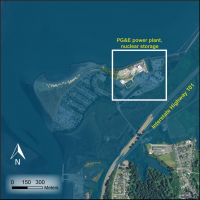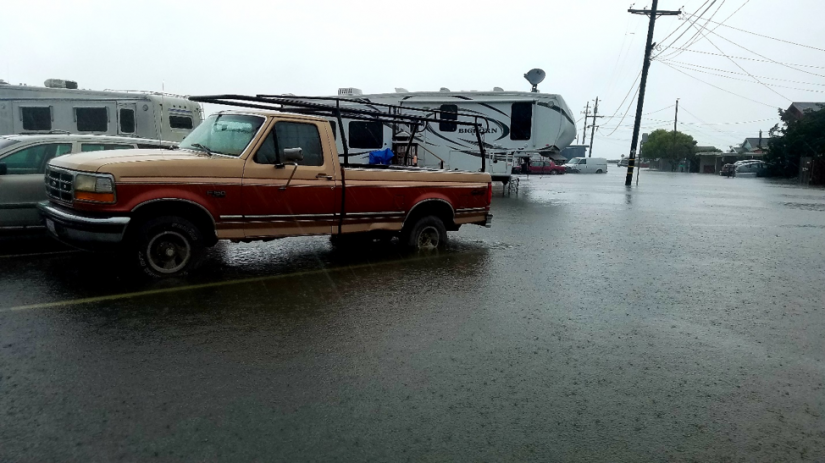Sea-level rise seems like a far-off problem for the future to deal with, right? We hear horror stories about Los Angeles and London being completely underwater if all the ice sheets in Greenland melt, but that sounds like another generation’s problem. Would you be surprised to learn that sea-level rise has already claimed two uninhabited islands in the country of Kiribati? It may be even more alarming to hear that extreme and regular flooding due to rising seas is already happening right here in California.
The small, coastal community of King Salmon in Humboldt County, California is likely at the highest risk of relative sea-level rise on the entire U.S. West Coast. Relative sea-level rise includes vertical land motion, in addition to changes in water level. King Salmon experiences rising waters at a rate nearly three times the global average because the land is sinking due to tectonic activity (earthquakes).
This community experiences flooding regularly, today. Like the rest of the world, it’s projected to get worse, and at an accelerated rate. In addition to water intruding from the Humboldt Bay, King Salmon also experiences flooding when groundwater rises with changing tides and storm surges. Plus there’s a nuclear plant there that ceased operations in 1976, where spent nuclear fuel is still stored on site, vulnerable to inundation. The average income within the community remains low, so many are unable to afford adaptation methods, multiplying the threat of rising seas. As part of my thesis research at Humboldt State University, I conducted personal interviews with the community to hear directly from the residents about their experiences with past flooding and their thoughts about future sea-level rise.


Flooding in King Salmon is not a new phenomenon, but it’s being exacerbated by sea-level rise. Archival data shows that this community has a long, recorded history of flood experiences over the past century. The U.S. Army Corps published four reports between 1936 and 1979 recognizing an escalation of erosion and flooding in the area, and numerous newspaper articles report severe flooding events from the 1980s to today. All seventeen participants I interviewed reported experiences with flooding within King Salmon. This is a community that coexists with floodwaters.
Many community members shared dramatic stories of flooding on their own property. One experienced a severe flooding event on the first day after he moved into his new home:
“I moved here in 2002, Thanksgiving Day actually. And a funny thing happened the following morning. I have, my bed is up on the second floor, and I have a window facing out on the street and I woke up and I look out the window and there's water flowing out from under the house into the street. The first night I was there. I thought what has happened? I thought the water main broke or something in the house, huh? And I go running downstairs and there's, in the back where the channel is, there's a little curb wall that a deck is built and the deck overhangs the channel and there was a hole eroded under that little curved wall and the water was just flowing into the backyard.”

Another resident described “2-3 inches of water in our house… we had to have had 20-24 inches of water in our yard.” He described in detail how water began seeping up through his hardwood floorboards in their library room, not rushing through the front door as he expected. They discovered later that their library room was two inches lower in elevation than the rest of their house. That minor elevation difference of two inches was enough to cause thousands of dollars in damage. Two other residents talked about floodwaters damaging their vehicles. One reported that his insurance company deemed his car totaled after ocean water entered the brakes and floorboards, even with the car elevated on cinderblocks. These remarkable stories of flooding reveal the challenging experiences King Salmon residents regularly face.
Sea-level rise is impacting countless coastal towns like King Salmon today. This isn’t a problem for future-us, this is a problem for us, now. Fortunately, our local communities are already beginning to adapt. As part of my work as a California Sea Grant state fellow with the State Lands Commission, I am reviewing and summarizing sea-level rise vulnerability assessments submitted by local California cities, counties, and ports as required by a 2013 bill, AB 691. Most of the vulnerability assessments submitted are posted on the State Lands Commission website, and the summaries I am creating will be shared there by the end of 2020. Many of our California communities have some great ideas on how to adapt to rising seas, including nature-based solutions like living shorelines in San Francisco, or relocating infrastructure to allow the water to reclaim land in Marina.
You can visualize potential sea-level rise effects in your own community with several online tools, like Our Coast Our Future, Adapting to Rising Tides, or the State Lands Commission’s Sea Level Rise Viewer. While the future remains uncertain, California communities are already starting to plan for and adapt to the future effects of rising tides. We cannot wait to act, but the slow-moving and predictable nature of sea-level rise creates an opportunity for us to get ahead of the curve today.
